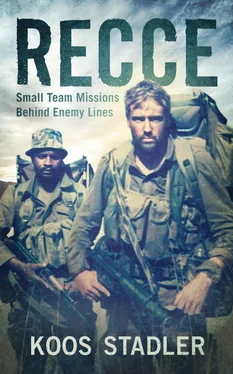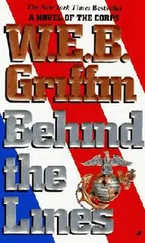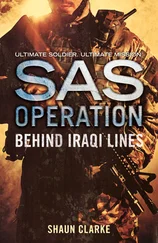By June 1985 the MPLA had initiated two large-scale offensives against UNITA, one in the Cazombo salient in the east and the second against Mavinga in the southeast, forcing Jonas Savimbi’s forces to fight on two fronts. Soviet and Cuban advisors guided the MPLA operations, and large numbers of SWAPO’s semi-conventional troops and ANC cadres, who were being trained in Angola, took part in the operations. The SADF viewed these offensives as part of the total onslaught and a direct threat to stability in South Africa.
After Dave’s overview, Diedies gave a brief outline of the mission, though not covering any details of timings and positions. We would deploy with UNITA to shoot down MPLA transport aircraft, utilising captured Russian SA-9 missile systems attached to the BRDM-2 armoured vehicle. Should we shoot down an aircraft, UNITA would claim the success. Although this was not a classic Small Team mission, I was grateful for the opportunity to learn. I had heard much about deployments with UNITA and was eager for first-hand experience.
Diedies and I drove to Pretoria for briefings and to marry up with the Air Force’s anti-aircraft specialists handling the missile systems. Back at Phalaborwa the operational teams started preparing their equipment under the guidance of Dave Scales. Dave maintained a modular Tac HQ that could be reduced or augmented depending on the requirement – whether on foot, in a vehicle or in established headquarters. He took care to pack equipment that could be transported by air and deployed at Rundu. The operators prepared their equipment, rations, water and a reserve for possible resupply. Then, under the pretext that they were going on a training exercise, the operational team went to Sawong, [12] Sawong was an acronym for “Suid-Afrikaanse Weermag Operasionele Navorsingsgebied”, or South African Defence Force Operational Research Area.
a secluded training area on the banks of the Olifants River outside Phalaborwa, for a two-week rehearsal.
While I was in Pretoria I met up with a friend who told me he wanted to introduce me to a girl he thought I would get along with. “She’s a teacher, she’s fun and she’s also a fitness fanatic… runs road races and stuff,” he explained.
“Thanks,” I said, “but you know I’m a bit tied up and will be going away for a few months.”
At the back of my mind I was also thinking of our unspoken policy that, once a guy got involved in a serious relationship, or wanted to marry, he would quit Small Teams of his own accord. I didn’t want to get bogged down in a relationship when I had just started what I had so long aspired to do.
“Well, think about it… You can always just be friends,” my friend persisted.
So I agreed to meet Zelda the following day. And because she was beautiful, clever, fun-loving and a fitness fanatic, I was hooked right from the start. While my friend had obviously informed her that I was a Recce, I did not volunteer any further information. Zelda was smart enough to realise that she shouldn’t prompt me for more details, and accepted from the outset that I would often be away.
After a week of planning and briefings at Special Forces HQ, Diedies and I returned to Phalaborwa to join the rest of the teams for final preparations and rehearsals at Sawong. Once we were ready, we were picked up by C-130 from Hoedspruit Air Force Base and flown to Pretoria, where the SA-9 missile systems were loaded onto two C-130s under the cover of darkness. The Tac HQ and all our personal equipment went in with the vehicles.
The flight to the operational area was scheduled for the afternoon so that we would arrive at Rundu, the headquarters of Sector 20, after dark. The SAM-9s were offloaded and we moved our equipment to Fort Foot, where we would stay for a few days before the deployment. Fort Foot, 1 Recce’s operational base at Rundu, was situated inside the perimeter of the larger headquarters base. Adjacent to the fort was the Chief of Staff Intelligence (CSI) base, from where all liaison operations with UNITA in eastern Angola were coordinated.
The next morning Diedies and I went to meet our UNITA guide, a young captain only introduced to us as Mickey, at the CSI base. Mickey was an amiable guy with whom we would cooperate closely for years to come. He spoke English well and had an intimate knowledge of the situation in Angola. He knew the locations of the FAPLA deployments in our area of operations and, even better, knew personally all the UNITA commanders of the bases that we would travel through.
The SAM-9 crews used the opportunity to do a final rehearsal on the systems, locking on to just about every aircraft that came in to land at Rundu. This initially caused some consternation and a few near-crashes, as the pilots of the fighter jets had not been informed, and got some nasty missile scares. In the meantime Dave Scales had set up Tac HQ in Fort Foot and was testing and monitoring the frequencies we’d be using. As always, he had the most practical and well-coordinated system going, and had us rehearsing comms procedures endlessly.
Oom Boet Swart, the Ops commander, kept us in good spirits all the way. I loved the old man dearly, even more so because we shared a love of classical music. In those days, the SADF had a fifty-fifty language policy for formal communications, which required English and Afrikaans to be used in alternate months. As it was the English-speaking month, Boet, whose real name was Mathewis, insisted on being referred to as “Matthew Black”. He reckoned this pseudonym would enhance the clandestine nature of our mission, since no one would suspect he was a “regte Boer”.
The time for the deployment came and we crossed the Cubango (Kavango) River with a UNITA pontoon at night, taking the heavy BRDM-2 vehicles across one at a time. Most of the Small Team operators had made themselves comfortable on the camouflage netting next to the vehicle’s turret. We actually tied ourselves to the superstructure so as not to be wiped off by branches. And so began the long and tedious journey along a sandy vehicle track, from one UNITA base to the next, to our final destination along the Gimbe River.
During the afternoon of day three, there was a grinding of gears and the vehicle I was riding on suddenly packed up. Diedies, in consultation with Lappies Labuschagne, our vehicle technician, made the call to move on with one BRDM and a UNITA escort. I would stay behind with the disabled vehicle and a contingent of UNITA soldiers. As soon as a recovery vehicle could be organised, I would move on and meet up with the main force at a UNITA headquarters base 100 km further along our route. If the vehicle could not be recovered, Diedies would continue the operation with the one SAM-9 and a UNITA protection element.
During those few days on my own with UNITA, I realised how much could be done with almost nothing. I was astonished by the sheer genius, clever improvisation and perseverance of the UNITA soldiers. Since Captain Mickey had departed with the main group, I was left without an interpreter and in the company of the UNITA detachment commander whose English was about as limited as my Portuguese – which was nonexistent. Nevertheless, he told me not to worry, as they were just waiting for a vehicle and some shovels. I couldn’t figure out what purpose it could possibly serve, as the BRDM-2 weighed at least 8 tons. There was no way of towing it through the dense bush on the sandy vehicle track. I honestly couldn’t see a way out and was dismayed that I would probably miss out on a great experience.
Early the next morning I heard a Kwêvoël arriving. A swarm of youngsters, each armed with a pick or a shovel and cackling excitedly, jumped off the back of the truck. The commander approached me with a big smile on his face. They clearly had a plan, but for the life of me I couldn’t figure it out. Then a heavily loaded Mercedes truck arrived and my enthusiastic colleague indicated to me that we should move all the equipment from the BRDM onto the Mercedes.
Читать дальше












